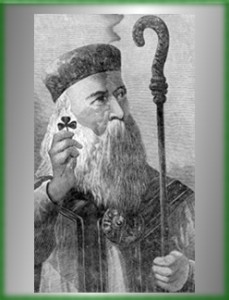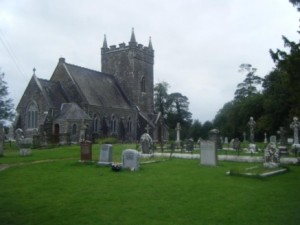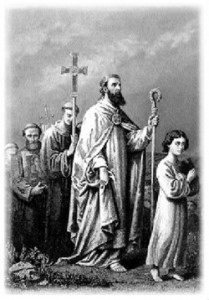Twice Patrick pleaded for the Faith before Leoghaire. The king had given orders that no sign of respect was to be extended to the strangers, but at the first meeting the youthful Erc, a royal page, arose to show him reverence; and at the second, when all the chieftains were assembled, the chief-bard Dubhtach showed the same honor to the saint. Both these heroic men became fervent disciples of the Faith and bright ornaments of the Irish Church.
 It was on this second solemn occasion that St. Patrick is said to have plucked a shamrock from the sward, to explain by its triple leaf and single stem, in some rough way, to the assembled chieftains, the great doctrine of the Trinity. On that bright Easter Day, the triumph of religion at Tara was complete. The Ard-Righ granted permission to Patrick to preach the Faith throughout the length and breadth of Erin, and the druidical prophecy like the words of Balaam of old would be fulfilled: the sacred fire now kindled by the saint would never be extinguished. The beautiful prayer of St. Patrick, popularly known as “St. Patrick’s Breast-Plate”, is supposed to have been composed by him in preparation for this victory over Paganism.
It was on this second solemn occasion that St. Patrick is said to have plucked a shamrock from the sward, to explain by its triple leaf and single stem, in some rough way, to the assembled chieftains, the great doctrine of the Trinity. On that bright Easter Day, the triumph of religion at Tara was complete. The Ard-Righ granted permission to Patrick to preach the Faith throughout the length and breadth of Erin, and the druidical prophecy like the words of Balaam of old would be fulfilled: the sacred fire now kindled by the saint would never be extinguished. The beautiful prayer of St. Patrick, popularly known as “St. Patrick’s Breast-Plate”, is supposed to have been composed by him in preparation for this victory over Paganism.
St. Patrick remained during Easter week at Slane and Tara, unfolding to those around him the lessons of Divine truth. Meanwhile the national games were being celebrated a few miles distant at Tailten (now Telltown) in connection with the royal feast. St. Patrick proceeding thither solemnly administered baptism to Conall, brother of the Ard-Righ Leoghaire, on Wednesday, 5 April. Benen and others had already been privately gathered into the fold of Christ, but this was the first public administering of baptism, recognized by royal edict, and hence in the ancient Irish Kalendars to the fifth of April is assigned “the beginning of the Baptism of Erin”.
This first Christian royal chieftain made a gift to Patrick of a site for a church which to the present day retains the name of Donagh-Patrick. The blessing of heaven was with Conall’s family. St. Columba is reckoned among his descendants, and many of the kings of Ireland until the eleventh century were of his race. St. Patrick left some of his companions to carry on the work of evangelization in Meath, thus so auspiciously begun. He would himself visit the other territories. Some of the chieftains who had come to Tara were from Focluth, in the neighborhood of Killala, in Connaught (the province of Connaught (Connacht) lies in the West of Ireland with its coastline on the Atlantic Ocean. The counties of Mayo, Sligo, Leitrim, Galway and Roscommon are within its boundary), and as it was the children of Focluth who in vision had summoned him to return to Ireland, he resolved to accompany those chieftains on their return, that thus the district of Focluth would be among the first to receive the glad tidings of Redemption.

Donaghpatrick or Domhnach-Pádraig, ‘the church of St. Patrick. A church and monastery which were founded by St. Patrick. After the Anglo-Norman invasion Donaghpatrick became a parish church.
It affords a convincing proof of the difficulties that St. Patrick had to overcome, that though full liberty to preach the Faith throughout Erin was granted by the monarch of Leoghaire, nevertheless, in order to procure a safe conduct through the intervening territories whilst proceeding towards Connaught he had to pay the price of fifteen slaves. On his way thither, passing through Granard he learned that at Magh-Slecht, not far distant, a vast concourse was engaged in offering worship to the chief idol Crom-Cruach. It was a huge pillar-stone, covered with slabs of gold and silver, with a circle of twelve minor idols around it. He proceeded thither, and whith his crosier smote the chief idol that crumbled to dust; the others fell to the ground. At Killala he found the whole people of the territory assembled. At his preaching, the king and his six sons, with 12,000 of the people, became docile to the Faith. He spent seven years visiting every district of Connaught, organizing parishes, forming dioceses, and instructing the chieftains and people.
One the occasion of his first visit to Rathcrogan, the royal seat of the kings of Connaught, situated near Tulsk, in the County of Roscommon, a remarkable incident occurred, recorded in many of the authentic narratives of the saint’s life. Close by the clear fountain of Clebach, not far from the royal abode, Patrick and his venerable companions had pitched their tents and at early dawn were chanting the praises of the Most High, when the two daughters of the Irish monarch — Ethne, the fair, and Fedelm, the ruddy — came thither, as was their wont, to bathe. Astonished at the vision that presented itself to them, the royal maidens cried out: “Who are ye, and whence do ye come? Are ye phantoms, or fairies, or friendly mortals?” St. Patrick said to them: “It were better you would adore and worship the one true God, whom we announce to you, than that you would satisfy your curiosity by such vain questions.” And then Eithne broke forth into the questions:
“Who is God?”
“And where is God?”
“Where is His dwelling?”
“Has He sons and daughters?”
“Is He rich in silver and gold?”
“Is He everlasting? is He beautiful?”
“Are His daughters dear and lovely to the men of this world?”
“Is He on the heavens or on earth?”
“In the sea, in rivers, in mountains, in valleys?”
“Make Him known to us. How is He to be seen?”
“How is He to be loved? How is He to be found?”
“Is it in youth or is it in old age that He may be found?”

But St. Patrick, filled with the Holy Ghost, made answer:
“God, whom we announce to you, is the Ruler of all things.”
“The God of heaven and earth, of the sea and the rivers.”
“The God of the sun, and the moon, and all the stars.”
“The God of the high mountains and of the lowlying valleys.”
“The God who is above heaven, and in heaven, and under heaven.”
“His dwelling is in heaven and earth, and the sea, and all therein.”
“He gives breath to all.”
“He gives life to all.”
“He is over all.”
“He upholds all.”
“He gives light to the sun.”
“He imparts splendour to the moon.”
“He has made wells in the dry land, and islands in the ocean.”
“He has appointed the stars to serve the greater lights.”
“His Son is co-eternal and co-equal with Himself.”
“The Son is not younger than the Father.”
“And the Father is not older than the Son.”
“And the Holy Ghost proceeds from them.”
“The Father and the Son and the Holy Ghost are undivided.”
“But I desire by Faith to unite you to the Heavenly King, as you are daughters of an earthly king.”
